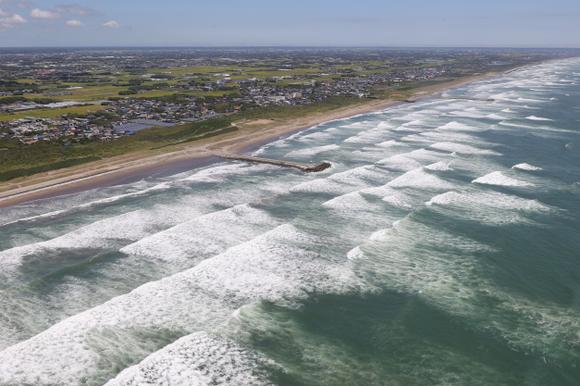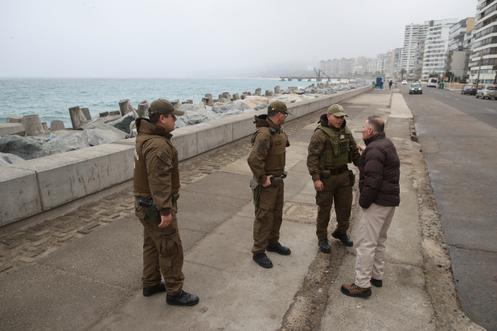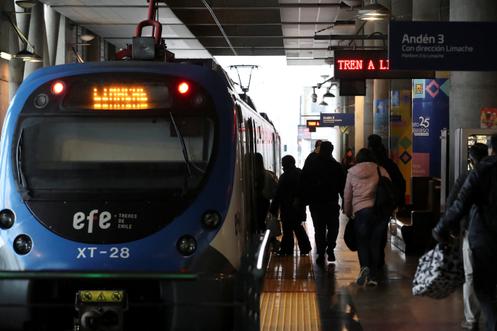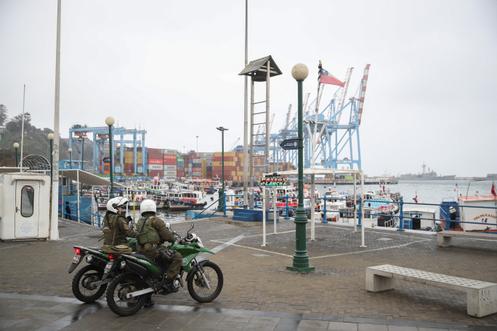Live, tsunami warnings in the Pacific: alert lifted in French Polynesia, South American countries on alert after powerful earthquake

Ask your question to the editorial staff:
Chilean Interior Minister Alvaro Elizalde announced Wednesday the evacuation of about 1.4 million people from the country's coastal areas to protect them from the tsunami triggered by the massive earthquake in the Pacific off the coast of Russia.
According to authorities, it could be "perhaps the largest evacuation ever carried out" in the country.
No damage was immediately reported after the first tsunami waves hit the country.
Although no casualties have yet been announced by the various countries affected by tsunami alerts, a woman nevertheless died in the Russian peninsula of Kamchatka, shaken by the earthquake and its aftershocks, while she was trying to escape from a cliff in her car.
July 30 at 9:00 p.m. The essentials
- Tsunami warnings have been issued across the Pacific after an 8.8 magnitude earthquake off Russia's Kamchatka Peninsula , the most powerful in the region in nearly 73 years, prompted evacuations.
- The first waves hit the Marquesas Islands in French Polynesia overnight, but the tsunami warning has been lifted by authorities on land. However, the geophysics laboratory predicts " a second arrival in the coming hours, with waves of lower height," and "vigilance and a ban on nautical activities" have been maintained.
- While several people were slightly injured in eastern Russia, none of the countries affected by tsunami warnings on either side of the Pacific have yet reported any deaths. Coastal populations have been evacuated, particularly in Japan and Peru, which has closed several of its ports.
- In the United States, the threat of a major tsunami "has completely passed," said Homeland Security Secretary Kristi Noem, predicting "minimal impact" on the West Coast, which is still on alert.
- The Klyuchevskoy volcano, located on Russia's Kamchatka Peninsula, erupted following a powerful earthquake and subsequent tsunamis in the Far Eastern region, the Russian Academy of Sciences' Joint Geophysical Service reported.
- Several countries have lifted or downgraded tsunami warnings issued earlier , including Russian authorities in Kamchatka and Japan across the country. The U.S. tsunami warning center also announced it was downgrading tsunami warnings in several states across the country.
July 30 at 8:30 p.m. Your questions
As Franck Lavigne of the Physical Geography Laboratory explained to Le Monde , "tsunamis are not linked to climate. They are geological phenomena." However, there may be some indirect effects. "For example, in some countries like Norway, melting glaciers weaken the slopes. This can lead to landslides which, if they fall into a fjord or the sea, can cause a localized tsunami," he explains.
With the tsunami alert lifted, the Secretary General of the High Commission in French Polynesia, Xavier Marotel, welcomed "a frankly positive assessment" . ensuring that no major material damage had been recorded at this stage, while calling on the inhabitants of the archipelago to be "cautious".
A military aircraft took off at 4:20 a.m. (4:20 p.m. Paris time) from Tahiti and flew over the Marquesas Islands at around 7 a.m. (9 a.m. Paris time) to carry out aerial reconnaissance and "consolidate [an] assessment of the material damage." Mr. Marotel said during a press conference broadcast on social media.
The Secretary General assured that French Polynesia had been able to cope with the consequences of the earthquake "with the right reactions." He praised the work of the forecasting agencies which made it possible to "see the tsunami from very far away" and provide "very precise and reliable" data to anticipate its progress, but also of the State services to "prepare shelters." "All the people who had to evacuate evacuated without difficulty," he added.
"We had no damage, no casualties and good organization thanks to the effective activation of the safeguard plans," Anny Pietri, head of the Marquesas subdivision, stressed on the spot to Agence France-Presse, after a meeting with the town halls of the three most affected islands, where 700 of the 6,119 inhabitants had been brought to safety. "They followed the instructions well," she said.
"We are going to have aftershocks, it will start again on a lesser scale," warned Mr. Marotel, however, calling for "caution" and warning in particular of the risk of a "seismic resurgence" in the next ten to twenty days, which could revive the risk of a tsunami on the islands of the archipelago.
07/30 at 7:22 p.m. To learn more
Franck Lavigne from the Physical Geography Laboratory, a specialist in fluvial and coastal hydrosystems, looks back at the mechanisms of tsunamis after numerous alerts were issued in the Pacific.
 Toshiyuki Kon/The Yomiuri Shimbun via Reuters Connect
Toshiyuki Kon/The Yomiuri Shimbun via Reuters ConnectAn 8.8-magnitude earthquake struck off Russia's Kamchatka Peninsula on Tuesday, July 29, triggering tsunamis across the Pacific. Franck Lavigne, a specialist in river and coastal hydrosystems from the Physical Geography Laboratory at the French National Center for Scientific Research, discusses the mechanisms of tsunamis and their danger, even when they appear moderate.
In the Marquesas archipelago, "the population can return to their usual place of residence, while avoiding the coasts as well as rivers and valleys, and exercising caution," announced the high commission in a new press release .
"Impacts of the ocean wave were observed by the geophysics laboratory (LDG) in the Marquesas, with a maximum height of 1.50 meters in Taiohae Bay, in Nuku Hiva, during the night," he said. The laboratory "observed an attenuation of the oscillations, but the LDG predicts a second arrival in the next few hours, with waves of a lower height (50 centimeters)." he adds.
Based on this information, the land alert has been lifted, reports the High Commission, which nevertheless maintains "vigilance and the ban on nautical activities throughout the Marquesas archipelago." Ships are not allowed to return to shore.
"At this stage, no injuries or major damage have been reported," he added.
July 30 at 6:50 p.m. Your questions
Peru has closed 65 of its 121 ports in response to a tsunami warning, the National Emergency Operations Center (COEN) announced Wednesday. The Peruvian Navy recommended suspending port and fishing activities and urged residents to stay away from the ocean.
According to Peru's National Emergency Center, the first waves were expected to arrive at the port of La Cruz, located in the Tumbes region on the border with Ecuador, on Wednesday around 10:10 a.m. (5:10 p.m. Paris time).
"Wave heights on the Peruvian coast are expected to be between 1 and 2.31 meters, following the tsunami warning," the COEN said. The president of the Geophysical Institute of Peru, Hernando Tavera, told Agence France-Presse that "waves are not expected to exceed 3 meters high on the Peruvian coast."
1 account from €7.99/month
No commitment
- All our articles, videos, podcasts and newsletters
- The La Matinale du Monde application, from 7 a.m., the editorial staff's selection of articles
- The daily newspaper in digital version from 1 p.m.
"We are in a good position right now, the tsunami threat that had been established in Hawaii and other areas like Alaska has been lowered. We are still on tsunami alert on the West Coast, but we expect minimal impact," said US Secretary of Homeland Security Kristi Noem at a press conference.
"We were fully mobilized and ready to respond if necessary, but we are grateful that we did not have to deal with the situation that could have arisen," Noem added to the press in Chile, where she is due to meet with authorities. According to the National Weather Service, San Francisco Bay could, however, see "really dangerous currents along the beaches and harbors." But the threat of a major tsunami "has completely passed," Noem assured.
July 30 at 6:35 p.m. In infographics 📈
"From one meter, a tsunami is already considered dangerous," assures Franck Lavigne, specialist in river and coastal hydrosystems, in an interview with Le Monde . "A tsunami has nothing to do with a wave to surf. The water rises suddenly, and moves at very high speed, and does not stop. It's like a dense torrent, but much faster," he adds.
July 30 at 6:17 p.m. Your questions
On this subject, we refer you to the response of Franck Lavigne, from the physical geography laboratory, specialist in fluvial and coastal hydrosystems, in his interview with Le Monde :
Buoys equipped with sensors placed in the open sea measure wave height in real time, making it possible to quickly detect the formation of a tsunami as soon as it begins, before it reaches the coast. The information is sent immediately to warning centers, which can then warn the population in time. This is what happened last night: a major earthquake occurred, and thanks to the sensors at sea, we knew fairly quickly that a tsunami had been triggered.
The 8.8 magnitude earthquake that struck the Pacific and the resulting tsunami risk caused the cancellation of hundreds of flights scheduled to cross the Pacific Ocean on Wednesday, as well as significant delays, according to the air traffic tracking website Flight Aware.
The website lists a total of more than 900 canceled flights for Wednesday. More than 181 flights to and from Shanghai Pudong International Airport were canceled, as were nearly 40 flights via Guangzhou Baiyun Airport. At the same airport, more than 840 flights were delayed.
July 30 at 5:40 p.m. In photos 📷



July 30 at 4:52 p.m. In infographics 📈
As tsunami waves are expected in French Polynesia, "all government services are mobilized to protect our citizens," assured the head of state, who called on residents to be vigilant and to follow "the instructions of local authorities."
"All my support to the Marquesans and all our compatriots in the Pacific," added the president in a message published on his X account.
The U.S. Tsunami Warning Center has lifted tsunami warnings for several areas of North America, including the coast of British Columbia, southern Alaska, the Alaska Peninsula, and the Aleutian Islands from Chignik Bay to Samalga Pass. The warning has also been lifted for American Samoa.
July 30 at 4:15 p.m. In infographics 📈
The Klyuchevskoy volcano, located on Russia's Kamchatka Peninsula, erupted following a powerful earthquake and subsequent tsunamis in the sparsely populated Far Eastern region, the Russian Academy of Sciences' Unified Geophysical Service reported on Telegram . "A molten lava flow is observed on the western slope. An intense glow above the volcano, explosions," the Russian Institute of Geophysical Monitoring added, citing photos taken by a camera installed at the seismic station.
Known as the largest active volcano in Eurasia, Klyuchevskoy, at 4,750 meters above sea level, has erupted several times in recent years.
07/30 at 3:27 p.m. In cards 🌏

Le Monde






